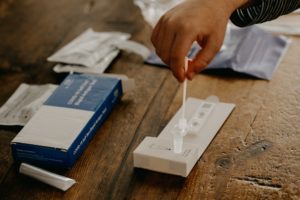 Isolation time cut to 5 full days (from the date of first positive test) for anyone who has recorded two consecutive daily negative lateral flow tests
Isolation time cut to 5 full days (from the date of first positive test) for anyone who has recorded two consecutive daily negative lateral flow tests
The requirement to isolate for 10 days remains in legislation, however from the 17th January, a person with a case of COVID-19 may take an LFD test on the fifth and sixth days of their isolation period. If both these LFD test results are negative, and they do not have a high temperature, they will be able to end their self-isolation after the second negative test result.
The LFD tests must be taken on consecutive days but the guidance will no longer stipulate that these tests should be taken at least 24 hours apart. This will shorten the minimum possible self-isolation from 6 full days (current guidance) to 5 full days. The Stay at home: guidance for households with possible or confirmed coronavirus (COVID-19) infection has been updated on the 17th January to reflect these changes.
 For example, if symptoms started at any time on the 15th of the month (or if the case was asymptomatic but their first positive COVID-19 test was taken on the 15th), they may take two daily LFD tests from the 20th. If LFD test results are negative on the 20th and 21st, and they do not have a high temperature, then the case will be able to end their isolation period after the negative test result on the 21st.
For example, if symptoms started at any time on the 15th of the month (or if the case was asymptomatic but their first positive COVID-19 test was taken on the 15th), they may take two daily LFD tests from the 20th. If LFD test results are negative on the 20th and 21st, and they do not have a high temperature, then the case will be able to end their isolation period after the negative test result on the 21st.
Further useful information
A useful visual tool to explain the changes in isolation period.
Order coronavirus (COVID-19) rapid lateral flow tests.
Isolation rules have changed – what does this mean for families and schools? – a useful blog post from the Education Hub (Department for Education).
